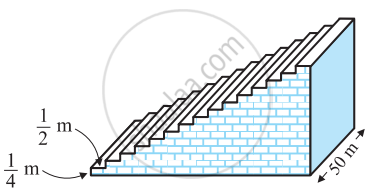Advertisements
Advertisements
प्रश्न
If 18th and 11th term of an A.P. are in the ratio 3 : 2, then its 21st and 5th terms are in the ratio
विकल्प
3 : 2
3 : 1
1 : 3
2 : 3
उत्तर
In the given problem, we are given an A.P whose 18th and 11th term are in the ratio 3:2
We need to find the ratio of its 21st and 5th terms
Now, using the formula
an = a + ( n -1) d
Where,
a = first tem of the A.P
n = number of terms
d = common difference of the A.P
So,
a18 = a + ( 18 - 1) d
a18 = a + 17d
Also,
a11 = a + ( 11 -1 ) d
a11 = a + 10 d
Thus,
`(a_18)/(a_11) = 3/2`
`( a + 17d) / ( a + 10 d) = 3/2`
2 (a + 17 d ) = 3 ( a + 10d)
2a + 3ad = 3a + 30d
Further solving for a, we get
34 d - 30d = 3a - 2a
4d = a .............(1)
Now,
a21 = a + (21 - 1) d
a21 = a + 20 d
Also,
a5 = a +( 5 -1) d
a5 = a + 4d
So,
`a_21/a_5 = ( a + 20d ) /( a + 4d) `
Using (1) in the above equation, we get
`a_21/a_5 = ( 4d + 20 d) / (4d + 4d) `
`a_21/a_5 = (24d)/(8d)`
`a_21 / a_5 = 3/1`
Thus, the ratio of the 21st and 5th term is 3: 1 .
APPEARS IN
संबंधित प्रश्न
A small terrace at a football field comprises 15 steps, each of which is 50 m long and built of solid concrete. Each step has a rise of `1/4` m and a tread of `1/2` m (See figure). Calculate the total volume of concrete required to build the terrace.
[Hint: Volume of concrete required to build the first step = `1/4 xx 1/2 xx 50 m^3`]

In a flower bed, there are 43 rose plants in the first row, 41 in second, 39 in the third, and so on. There are 11 rose plants in the last row. How many rows are there in the flower bed?
Find the sum of the following Aps:
9, 7, 5, 3 … to 14 terms
Choose the correct alternative answer for the following question .
15, 10, 5,... In this A.P sum of first 10 terms is...
The first and last term of an A.P. are a and l respectively. If S is the sum of all the terms of the A.P. and the common difference is given by \[\frac{l^2 - a^2}{k - (l + a)}\] , then k =
Find the sum of numbers between 1 to 140, divisible by 4
If the sum of the first m terms of an AP is n and the sum of its n terms is m, then the sum of its (m + n) terms will be ______.
In an AP if a = 1, an = 20 and Sn = 399, then n is ______.
The first term of an AP of consecutive integers is p2 + 1. The sum of 2p + 1 terms of this AP is ______.
Which term of the AP: –2, –7, –12,... will be –77? Find the sum of this AP upto the term –77.
